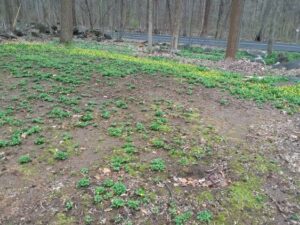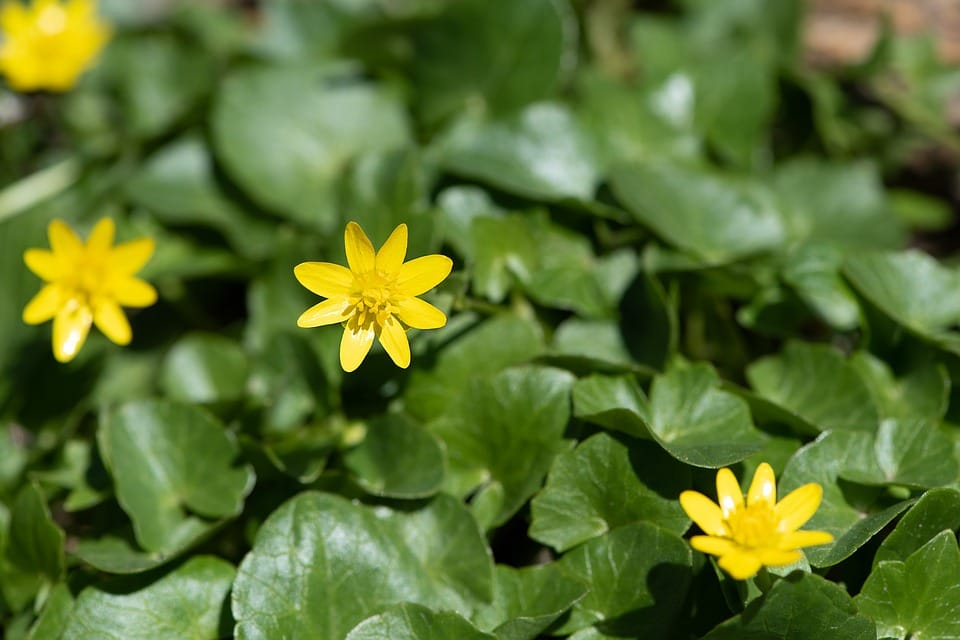Lesser Celandine or Fig Buttercup
Nice looking but Undesirable!
Lesser celandine, Ficaria verna (also known as fig buttercup) is a weed that is labeled invasive and for good reasons. It’s an aggressive plant and when found growing in a dense pattern in the forest, will shade out nearly all the native ephemerals giving them little or no chance to survive. But homeowners also have to deal with this bad plant, and they find it a real nuisance and difficult to eradicate!
It appears early spring and has a sweet buttercup appearance…but don’t let that fool you! It grows vigorously, quickly forming large mats and out-competing with grass in the lawn, and plants in the garden.
History of Lesser Celandine
Lesser celandine is native to Europe, northern Africa, western Asia, and Siberia. It was brought to the US as an ornamental plant because of it attractive flowers and dark green leaves. It invades most woodlands but can also make its way into home settings.

Lesser Celandine (Fig Buttercup) taking over a bare area.
Appearance
As a member of the buttercup family, lesser celandine is a perennial flowering herbaceous plant. The leaves are a shiny, dark green kidney shape with wavy edges. The flowers are bright yellow with eight to 12 petals and reach up to three inches wide. It’s actually attractive. It’s low growing and forms a dense ground coverage once established.
Habits of Lesser Celandine
Lesser celandine is one of the first plants to emerge in early spring and if you’re not informed of its habits, you’ll be delighted by its bright flowers against all the dormant plants yet to grow. It particularly likes moist soil, but can be found growing up steep hills where water and nutrients are scarce. Lesser celandine will grow in full sun to full shade, and thrive in any kind of soil. It’s low-growing and spreads to form a thick mat of yellow flowers. It spreads through bulblets and underground tubers. The tiny bulblets are attached to the leafstalks. Underlying each plant is a mass of finger-shaped tubers that are produced by the roots.
After blooming early and they are finished reproducing, they go dormant by mid-June…often before the leaves on the trees are full-grown.
How to Control Fig Buttercup
Lesser celandine is challenging to control, let alone remove. Small infestations can be removed by hand digging and pulling from damp ground but make sure you don’t leave a bit of tuber behind, or it will multiply back into action.
With a lot of persistence, lesser celandine can be controlled chemically. Of course with any chemical, you should be careful about getting it close to amphibians or within 60 feet of water bodies and creeks.
Herbicides which contain the active ingredient glyphosate are effective in controlling (but not necessarily eradicating) lesser celandine. According to a fact sheet on control methods from the University of Washington, “ application timing and herbicide concentration must be correct to obtain control. Make application in late winter or early spring when leaves are visible, but prior to full flowering, and when temperatures are above 40 degrees F. Apply a 1 to l.5% rate of a 53.8% active ingredient glyphosate. An added non-ionic surfactant will improve herbicide uptake by the plant.” It may take 1-2 weeks before the full effects of the treatment are visible and be careful to treat only the Lesser celandine because it will affect other vegetation. And in closing, always follow manufacturer’s directions.
Don’t Be Confused
Lesser celandine can be confused with our desirable native marsh marigold. This plant is also a member of the buttercup family, but it does not have tubers on its roots or bulblets along its stem, and its flowers are a bit different. It forms solitary clumps rather than large mats.
Conclusion
Chances are you don’t have to worry about this invasive plant in your yard. But if you do, knowledge is power and we hope this description will inform you of the tactics you can take to rid your yard of this nuisance plant.
Always feel free to reach out to Whitehouse Landscaping for help with your landscaping. Our Property Care & Maintenance Services are all-encompassing and were created with all of your needs in mind. Whether it is landscape design and installation, hardscaping or landscape maintenance, let Whitehouse Landscaping be your one-stop-shop for your outdoor needs. Visit us on our website, or call 484-300-4290 if we can be of service.

